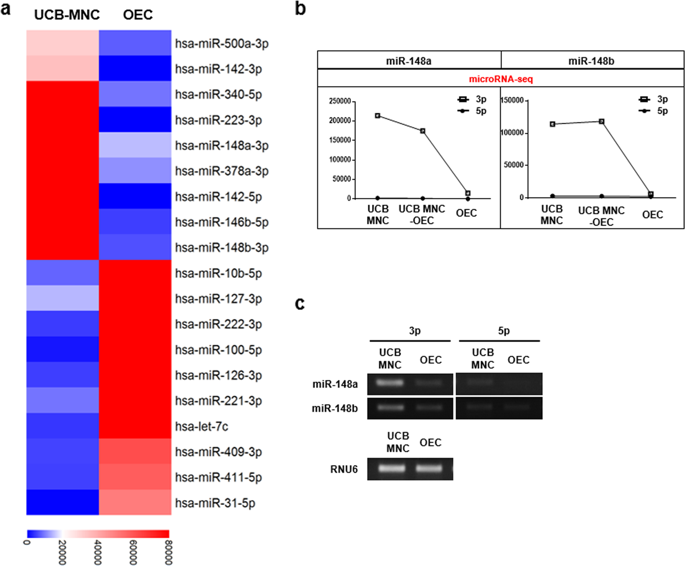Experimental & Molecular Medicine ( IF 9.5 ) Pub Date : 2019-11-13 , DOI: 10.1038/s12276-019-0344-x Hyejeong Kim 1 , Yeongrim Ko 1 , Hyojin Park 1 , Haiying Zhang 1 , Yoonjeong Jeong 1 , Yeomyeong Kim 1 , Minyoung Noh 1 , Songyi Park 1 , Young-Myeong Kim 2 , Young-Guen Kwon 1

|
MicroRNAs (miRs) are crucial regulators of vascular endothelial cell (EC) functions, including migration, proliferation, and survival. However, the role of most miRs in ECs remains unknown. Using RNA sequencing analysis, we found that miR-148a/b-3p expression was significantly downregulated during the differentiation of umbilical cord blood mononuclear cells into outgrowing ECs and that decreased miR-148a/b-3p levels were closely related to EC behavior. Overexpression of miR-148a/b-3p in ECs significantly reduced migration, filamentous actin remodeling, and angiogenic sprouting. Intriguingly, the effects of decreased miR-148a/b-3p levels were augmented by treatment with vascular endothelial growth factor (VEGF). Importantly, we found that miR-148a/b-3p directly regulated neuropilin-1 (NRP1) expression by binding to its 3′-untranslated region. In addition, because NRP1 is the coreceptor for VEGF receptor 2 (VEGFR2), overexpression of miR-148a/b-3p inhibited VEGF-induced activation of VEGFR2 and inhibited its downstream pathways, as indicated by changes to phosphorylated focal adhesion kinase (FAK), extracellular signal-regulated kinase (ERK), and p38 mitogen-activated protein kinase. Collectively, our results demonstrate that miR-148a/b-3p is a direct transcriptional regulator of NRP1 that mediates antiangiogenic pathways. These data suggest that miR-148a/b-3p is a therapeutic candidate for overcoming EC dysfunction and angiogenic disorders, including ischemia, retinopathy, and tumor vascularization.
中文翻译:

MicroRNA-148a/b-3p 通过靶向内皮细胞中的神经纤维蛋白 1 来调节血管生成。
MicroRNAs (miRs) 是血管内皮细胞 (EC) 功能的关键调节因子,包括迁移、增殖和存活。然而,大多数 miR 在 ECs 中的作用仍然未知。使用 RNA 测序分析,我们发现 miR-148a/b-3p 表达在脐带血单个核细胞分化为向外生长的 EC 过程中显着下调,并且 miR-148a/b-3p 水平的降低与 EC 行为密切相关。ECs 中 miR-148a/b-3p 的过表达显着减少了迁移、丝状肌动蛋白重塑和血管生成发芽。有趣的是,用血管内皮生长因子 (VEGF) 治疗增强了降低 miR-148a/b-3p 水平的效果。重要的是,我们发现 miR-148a/b-3p 通过与其 3'-非翻译区结合直接调节神经纤维蛋白 1 (NRP1) 的表达。此外,由于 NRP1 是 VEGF 受体 2 (VEGFR2) 的辅助受体,miR-148a/b-3p 的过表达抑制了 VEGF 诱导的 VEGFR2 活化并抑制其下游通路,如磷酸化粘着斑激酶 (FAK) 的变化所示、细胞外信号调节激酶 (ERK) 和 p38 丝裂原活化蛋白激酶。总的来说,我们的结果表明 miR-148a/b-3p 是 NRP1 的直接转录调节因子,可介导抗血管生成途径。这些数据表明 miR-148a/b-3p 是克服 EC 功能障碍和血管生成疾病(包括缺血、视网膜病变和肿瘤血管化)的治疗候选药物。如磷酸化粘着斑激酶 (FAK)、细胞外信号调节激酶 (ERK) 和 p38 丝裂原活化蛋白激酶的变化所示。总的来说,我们的结果表明 miR-148a/b-3p 是 NRP1 的直接转录调节因子,可介导抗血管生成途径。这些数据表明 miR-148a/b-3p 是克服 EC 功能障碍和血管生成疾病(包括缺血、视网膜病变和肿瘤血管化)的治疗候选药物。如磷酸化粘着斑激酶 (FAK)、细胞外信号调节激酶 (ERK) 和 p38 丝裂原活化蛋白激酶的变化所示。总的来说,我们的结果表明 miR-148a/b-3p 是 NRP1 的直接转录调节因子,可介导抗血管生成途径。这些数据表明 miR-148a/b-3p 是克服 EC 功能障碍和血管生成疾病(包括缺血、视网膜病变和肿瘤血管化)的治疗候选药物。











































 京公网安备 11010802027423号
京公网安备 11010802027423号